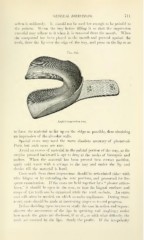Page 713 - My FlipBook
P. 713
GENERAL DIRECTIONS. 711
soften it uniformly. It slioiikl not he used hot enong-h to he painful to
the patient. Warm the tray hefore fillino' it so that the impression
material may adhere to it Avhen it is removed from the mouth. AVhen
the compound has been placed in the moutli and pressed against the
teeth, draw the lip over the edge of the tray, and press on the lip so as
Fig. 636.
Angle'.s impression tray.
to force the material as far up on the ridge as possible, thus obtaining
an impression of the alveolar walls.
Special cases may need the more absolute accuracy of plaster-of-
Paris, but such cases are rare.
Avoid an excess of material in the palatal portion of the tray, as the
surplus pressed backward is apt to drag at the necks of bicuspids and
molars. When the material has been pressed into correct position,
ajiply cold water with a syringe to the tray and under the lip and
cheeks till the material is hard.
Casts made from these impressions should be articulated either with
wire hinges or by extending the rear portions, and preserved for fre-
quent examination. If the casts are held together by a '' plaster articu-
lator," it should be open in the rear, so that the lingual surfaces and
cusps of the teeth can be examined w hile the teeth occlude. An extra
east will often be needed, on which to make ap])liances. During treat-
ment, casts should be made at interesting stages to record progress.
Before deciding upon treatment study the case in action and repose;
observe the movements of the lips in speaking and laughing; notice
how much the gums are disclosed, if at all, or with what diilieultv the
teeth are covered by the lips. Study the profile. If the irregularitv


